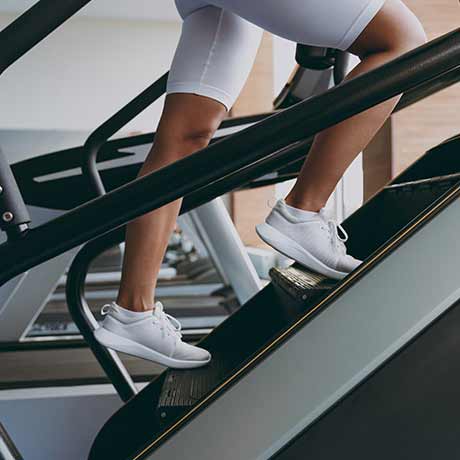- Private & confidential service
- Genuine medication
- All-inclusive service - No hidden fees
- Next day delivery
- Weight Loss
- The benefits of exercise for weight loss
- Walking and how it can help with weight loss
Walking and how it can help with weight loss
Did you know that the average person spends 9.5 hours sitting down each day? This may not seem like a lot, but it can lead to health problems, especially as obesity rates rise. Research has found that people who do not do much physical activity are more likely to be obese or have cardiovascular disease.
A simple way of increasing your activity is walking. Not only is it low-intensity, but it is also easy to add to your daily routine. Here we break down the benefits of walking for weight loss, your general health and some example workouts you can do.
Can I lose weight by walking?
Walking is a type of exercise that helps improve your endurance. This is because it trains your heart and breathing rate, strengthening your cardiovascular system. What this means is that you will be able to walk for longer without getting tired.
Your body uses more energy when you do cardio or any other moderate-intensity exercise. This is because it needs to use extra energy to help the exercise. The good news is that this also means your body starts to burn fat for energy. This can lead to weight loss.

For the best weight loss results, you need to walk at a brisk pace rather than just a stroll. The NHS advises a brisk walk for 10 minutes a day, which counts towards the 150 minutes of exercise advised weekly for adults.
However, any kind of walking or daily movement will help you lose weight if you are currently obese and leading a sedentary life. Walking 10,000 steps daily will burn 1-2 pounds of fat over a week.
What are the benefits of walking?
The main benefit of walking is that it is easy for the average person, no matter what your age or fitness level. You can easily add it to your routine by walking to work or the shops - it’s an easy type of cardio that improves fitness, increases your heart rate, and doesn’t leave you out of breath.

As well as being a practical form of exercise, it also has many health benefits.
Heart health
According to the NHS, heart disease is a problem that affects around 7 million people in the UK. It can lead to 1 in 4 premature deaths. Since walking is a very effective cardio exercise and strengthens the cardiovascular system, it is an effective way to prevent heart disease.
Adding just 30 minutes of walking a day can lower the risk of heart disease by 35%. The benefits are prevalent in older generations. One study found that in men aged 71-93 years old, walking more than 1.5 miles a day had a significantly decreased risk of heart disease.
Walking 30 minutes a day can lower your heart disease risk by 35%.
A more recent study found that increased walking in elderly populations saw a decrease in blood pressure.
Bone, muscle & joint health
Regularly walking for weight loss can also strengthen your bones and muscles.
One of the main benefits of walking is preventing muscle and bone pain. Once you hit 40, bone strength declines on average by 1% each year. This is a significant risk factor for osteoporosis, a condition that causes weak bones and injuries. One study observed the benefits in post-menopausal women. They found that walking 30 minutes per day reduced the risk of hip fractures by 40%.
Walking is also good for joint health. It encourages more nutrients to reach the joint cartilage, which keeps it healthier and prevents joint pain. Research on those with knee osteoarthritis saw significant reductions in knee pain.
Brain health
Walking is also good for the brain. It keeps your brain active and helps with focus, memory and other cognitive abilities. Studies have shown that walking can significantly reduce cognitive decline and the risk of conditions like Alzheimer’s.
It is also good for your mental health. Walking, as well as other forms of exercise, release endorphins. Research has suggested that long-distance and rural walks help improve mental health in the long and short term.
Are there any disadvantages to walking for weight loss?
Walking for weight loss has a multitude of benefits. However, for some, walking may not be the best exercise. Here are some potential disadvantages of walking:
- It’s slow-paced - it may be boring or too easy for people who like high-intensity cardio.
- It’s not as efficient for fat loss - it may take longer for some to see results if walking is your only exercise.
- Not efficient for muscle training - too much cardio in your routine can mean you spend too much energy on cardio rather than muscle building.
- Neglects upper body - does not involve the upper body muscles.
- Too strenuous - for some, long or brisk walks may be too difficult and could cause injury. Consult your doctor.
These points don’t mean walking isn’t a good exercise for weight loss, it’s more about what works for your fitness journey.
Is running better than walking for fitness?
Whether you choose to run or walk will depend on your fitness level.
Running will burn double the number of calories than walking will. If you run steadily for 30 minutes, you can burn 200-500 calories, depending on how fast you run. It’s more strenuous than walking, so it will improve your cardio and strengthen your joints more than walking will.
However, running isn’t for everyone. For beginners, it may be too difficult and intensive to start with jogging. In addition, some people may not be able to run due to a health problem. For those people, walking is a great alternative and will still improve your fitness overall. Perhaps once you’re comfortable walking, you can try jogging.
Beginner’s 30-minute walking workouts
Here is a range of different walking workouts for all abilities. They are low-impact but still burn some serious calories. They all can be done in 30 minutes or less!
Power walking
Power walking involves walking at a higher speed than your normal pace, which is around 4 - 5.5mph. Unlike jogging, you must have one foot in contact with the ground at all times.

It requires a specific technique. When you power walk, make sure to:
- keep your arms at a 90° angle
- have good posture - don’t lean forwards
- take smaller steps
These tips will help you get the most out of your power walk. When you go to power walk, make sure you start by walking at a comfortable pace to start with. See below for a beginner’s power walking split.
| Power walk at a fast pace | 5 - 10 minutes |
| Walk at a comfortable pace | 20 minutes |
| Walk at a slow speed to cool down | 5 minutes |
The 12-3-30 method
If you have a gym membership or have a treadmill at home, a simple but challenging workout you can do is known as the 12-3-30 method.
- Set the treadmill to an incline of 12.
- Set the treadmill to a 3.0 speed.
- Walk for 30 minutes.
That’s it! It’s simple enough to do regularly but hard enough to feel rewarded afterwards.
As this workout is designed for the treadmill, feel free to decrease the incline slightly or increase the pace according to how it feels.
Online walking workouts
If you don’t have space outdoors to walk or don’t have access to a treadmill, plenty of workouts are available.
There are a plethora of walking workouts available online. They involve walking on the spot with many movement variations. Some include dumbbells or movements that work other muscle groups (such as abs or arms).
They’re a great way to get started if you have little equipment and you want a full-body burn.
1. "Beginners Do This Everyday to Burn Fat (2 Mile Walk)” by growwithjo

2. "30 MIN WALKING CARDIO WORKOUT | Intense Full Body Fat Burn at Home” by emi wong

3. "5000 STEPS NO REPEAT WALKING WORKOUT | No Jumping” by Olivia Lawson

Climbing stairs or uphill walking
Another way you can make walking more interesting is to climb steps. It’s a great option if you are shorter on time because it is more intensive.
- Start walking on flat ground for 5 minutes to warm up.
- Walk up the stairs at a steady pace for 2 minutes.
- Walk back down the stairs at a steady pace for 2 minutes.
- Rest for 1 minute.
- Repeat for 15-20 minutes.

Alternatively, if your gym has the equipment, you could do a similar workout on a climber or step machine.
What should I eat before and after a walking workout?
Before a workout, you must be energised. However, you should still eat something healthy.
Choose a food which is rich in carbohydrates. This will give you long-lasting energy that will get you through your workout. Foods like wholegrain bread, sweet potatoes, beans, legumes and oats are all good sources of healthy carbs.
After eating, you should try to walk within an hour of eating. This is because your blood sugar spikes around 70 minutes after eating, so you will get the most out of your meal if you start walking just before it peaks.
Then after your workout eat a healthy, balanced meal that is rich in both protein and carbohydrates to re-fuel your muscles and energy stores.
What should I eat during a walking workout?
There is some disagreement on whether you should eat whilst you walk. Some studies show that it can improve digestion. However, other studies have found it can mean your brain doesn’t register it as a meal, so you feel hungrier later.
For long walking workouts (longer than 90 minutes), you should eat some carbohydrates in between to stay energised. However, a heavy meal can cause a stitch. So stick to a light but a high-carb meal.
How do you get started with walking workouts?
You don’t need much to start walking. Just put on some comfortable clothes, your walking shoes and your favourite music or podcast. Mobile apps and devices can help you track your walking pace, distance and steps. You could even join a walking group and make some friends whilst motivating each other.
However, it’s a good idea to assess your fitness levels and tailor your goals before starting. You should also consult your doctor if you have any physical limitations, as they can help you decide what’s right for you.
How to make walking part of your day
The main benefit of walking is that it is very easy to add to your daily routine.
- If you have a daily commute, why not walk instead? Put on some music or podcast and enjoy the scenery to start your day.
- Try walking to the shops instead of shopping online. You may find something you didn't know you needed.
- You could also make it an activity with a loved one. Pick a scenic place to walk and make it a date.
Further reading
.jpg)
The benefits of exercise for weight loss Find your perfect exercise: tips for every fitness level
Reviewed by Dr. Plauto Filho
The benefits of exercise for weight loss Weight lifting for weight loss
Reviewed by Dr. Caroline Fontana
The benefits of exercise for weight loss Home workouts to lose weight
Reviewed by Dr. Caroline Fontana
The benefits of exercise for weight loss The best cardio exercises to lose weight
Reviewed by Dr. Caroline Fontanamedical form
medication
prescription
from pharmacy

